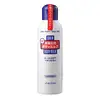What's inside
What's inside
 Key Ingredients
Key Ingredients

 Benefits
Benefits

 Concerns
Concerns

 Ingredients Side-by-side
Ingredients Side-by-side

Water
Skin ConditioningGlycerin
HumectantParaffinum Liquidum
EmollientButylene Glycol
HumectantCetyl Oleate
EmollientUrea
BufferingDimethicone
EmollientCetearyl Alcohol
EmollientPetrolatum
EmollientGlyceryl Stearate
EmollientPEG-60 Glyceryl Isostearate
Glycine
BufferingStearic Acid
CleansingIsostearic Acid
CleansingBehenic Acid
CleansingPotassium Carbomer
Emulsion StabilisingSodium Citrate
BufferingPotassium Isostearate
Potassium Behenate
CleansingMenthol
MaskingEDTA
Sodium Paraben
PreservativeWater, Glycerin, Paraffinum Liquidum, Butylene Glycol, Cetyl Oleate, Urea, Dimethicone, Cetearyl Alcohol, Petrolatum, Glyceryl Stearate, PEG-60 Glyceryl Isostearate, Glycine, Stearic Acid, Isostearic Acid, Behenic Acid, Potassium Carbomer, Sodium Citrate, Potassium Isostearate, Potassium Behenate, Menthol, EDTA, Sodium Paraben
Water
Skin ConditioningParaffinum Liquidum
EmollientGlycerin
HumectantAnnona Squamosa Fruit Extract
Skin ConditioningGlyceryl Stearate
EmollientPEG-100 Stearate
Caprylic/Capric Triglyceride
MaskingPotassium Hydroxide
BufferingLauroyl Lysine
Skin ConditioningHydrogenated Lecithin
EmulsifyingCholesterol
Emollient3-O-Ethyl Ascorbic Acid
Skin ConditioningButylene Glycol
HumectantPolyglyceryl-10 Stearate
Skin ConditioningPanthenol
Skin ConditioningSodium Ascorbyl Phosphate
AntioxidantTocopheryl Acetate
AntioxidantCaprylyl Glycol
EmollientGlyceryl Arachidonate
EmollientGlyceryl Linolenate
EmollientBiotin
AntiseborrhoeicRetinyl Palmitate
Skin ConditioningCetearyl Alcohol
EmollientCarbomer
Emulsion StabilisingDisodium EDTA
Methylparaben
PreservativePhenoxyethanol
PreservativePropylparaben
PreservativeParfum
MaskingWater, Paraffinum Liquidum, Glycerin, Annona Squamosa Fruit Extract, Glyceryl Stearate, PEG-100 Stearate, Caprylic/Capric Triglyceride, Potassium Hydroxide, Lauroyl Lysine, Hydrogenated Lecithin, Cholesterol, 3-O-Ethyl Ascorbic Acid, Butylene Glycol, Polyglyceryl-10 Stearate, Panthenol, Sodium Ascorbyl Phosphate, Tocopheryl Acetate, Caprylyl Glycol, Glyceryl Arachidonate, Glyceryl Linolenate, Biotin, Retinyl Palmitate, Cetearyl Alcohol, Carbomer, Disodium EDTA, Methylparaben, Phenoxyethanol, Propylparaben, Parfum
 Reviews
Reviews

Ingredients Explained
These ingredients are found in both products.
Ingredients higher up in an ingredient list are typically present in a larger amount.
Butylene Glycol (or BG) is used within cosmetic products for a few different reasons:
Overall, Butylene Glycol is a safe and well-rounded ingredient that works well with other ingredients.
Though this ingredient works well with most skin types, some people with sensitive skin may experience a reaction such as allergic rashes, closed comedones, or itchiness.
Learn more about Butylene GlycolCetearyl alcohol is a mixture of two fatty alcohols: cetyl alcohol and stearyl alcohol. It is mainly used as an emulsifier. Emulsifiers help prevent the separation of oils and products. Due to its composition, it can also be used to thicken a product or help create foam.
Cetearyl alcohol is an emollient. Emollients help soothe and hydrate the skin by trapping moisture.
Studies show Cetearyl alcohol is non-toxic and non-irritating. The FDA allows products labeled "alcohol-free" to have fatty alcohols.
This ingredient is usually derived from plant oils such as palm, vegetable, or coconut oils. There is debate on whether this ingredient will cause acne.
Due to the fatty acid base, this ingredient may not be Malassezia folliculitis safe.
Learn more about Cetearyl AlcoholGlycerin is already naturally found in your skin. It helps moisturize and protect your skin.
A study from 2016 found glycerin to be more effective as a humectant than AHAs and hyaluronic acid.
As a humectant, it helps the skin stay hydrated by pulling moisture to your skin. The low molecular weight of glycerin allows it to pull moisture into the deeper layers of your skin.
Hydrated skin improves your skin barrier; Your skin barrier helps protect against irritants and bacteria.
Glycerin has also been found to have antimicrobial and antiviral properties. Due to these properties, glycerin is often used in wound and burn treatments.
In cosmetics, glycerin is usually derived from plants such as soybean or palm. However, it can also be sourced from animals, such as tallow or animal fat.
This ingredient is organic, colorless, odorless, and non-toxic.
Glycerin is the name for this ingredient in American English. British English uses Glycerol/Glycerine.
Learn more about GlycerinGlyceryl Stearate is a mix of glycerin and stearic acid.
It is used to stabilize the mixing of water and oil ingredients. By preventing these ingredients from separating, it can help elongate shelf life. It can also help thicken the product's texture.
As an emollient, it helps soften skin and supports barrier-replenishing ingredients.
In cosmetics, Glyceryl Stearate is often made from vegetable oils or synthetically produced.
This ingredient may not be fungal-acne safe
Fun fact: The human body also creates Glyceryl Stearate naturally.
Learn more about Glyceryl StearateParaffinum Liquidum is also known as liquid paraffin. It is a type of highly refined mineral oil.
Like other oils, Paraffinum Liquidum has emollient properties. Emollients help soothe and soften the skin. By creating a barrier to trap moisture within, emollients help keep your skin hydrated.
Paraffinum Liquidum does not irritate the skin and is non-comedogenic.
Learn more about Paraffinum LiquidumWater. It's the most common cosmetic ingredient of all. You'll usually see it at the top of ingredient lists, meaning that it makes up the largest part of the product.
So why is it so popular? Water most often acts as a solvent - this means that it helps dissolve other ingredients into the formulation.
You'll also recognize water as that liquid we all need to stay alive. If you see this, drink a glass of water. Stay hydrated!
Learn more about Water